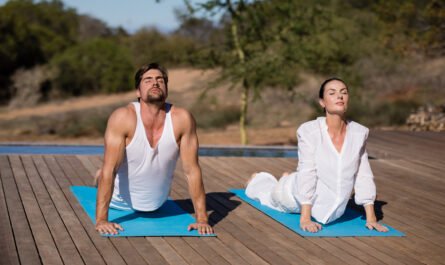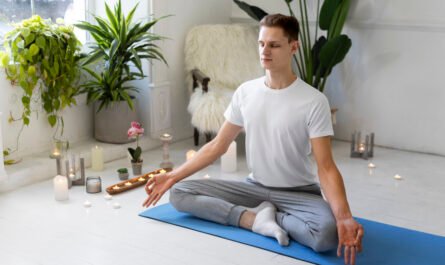Last year, when struggling with insomnia, yoga studio was my salvation. After reading Beginning Yoga by Vijayendra Pratap and reviewing each “calming” pose in his text book–my insomnia resolved within two days! It truly amazes me how effective yoga practice can be at helping one sleep!
One year later I relocated to Seattle where I met inspirational and engaging educators. While practicing myself for just two years I assumed I could also teach; then reality set in. No matter how much more study was still ahead for me; my partner gently reminded me that no matter my limitations I was still deeply committed to yoga; thus inspiring me to stay the course. His guidance remains my source of eternal gratitude!
At first I only attended weekend instructor training workshops; after just a couple weeks of that experience I began offering some yoga classes myself. Ten years later and with two additional yoga teacher courses completed along with yoga therapy certification and mediation teacher certification as well as my own personal studio at home (for yoga therapy sessions and regular personal practice), yoga remains one of my greatest loves – now more so than ever.
Here are my greatest lessons so far on my journey.
There’s no need to learn everything
Just because I am at the centre of your class doesn’t necessarily guarantee that only you possess yoga knowledge. When I began my first year teaching yoga classes, a pregnant lady attended and I read up as much information on prenatal yoga before helping manage her postures microscopically. At first I instructed her to lie on her side to do yoga savasana regardless of sleeping on her back and practicing traditional savasana during her first pregnancy, although traditional forms weren’t part of our program at that point. At that time she decided not to attend classes any further and I realized the limits of my “expertise”. After speaking with her for several sessions I realized how little authority I actually held; ultimately she was the expert when it came to her body, pregnancy state, routines etc. When someone comes in with specific issues I will ask more questions before maybe suggesting I can’t assist directly but working collaboratively to resolve said issue(s).
As I recall my experiences of instructing yoga classes and personal practices, my instructor always inquires of me “Does this feel better, worse or the same?” after suggesting changes or modifications; after giving a lesson she checks back with me afterward to assess whether her suggestions fit my body/mind/heart/spirit well; she doesn’t assume to know my responses in advance! Furthermore, knowing I don’t need to know all the details allows for less engrossing teaching sessions as well as more authentic educator practice!
The anatomy is vital, but as is calming the mind
As someone of my very first instructors told me: The body is an entrance into deeper and subtler dimensions of who we are; not an end in itself. I find its design truly amazing! While its physical form may dominate much of who we are today, physical forms only represent part of who we truly are.
Asana practice provides an effective workout, and individuals come for various reasons to the practice: healing of injuries or relieving chronic pain are among them; others seek solace from stress or grief relief or anxiety relief through this avenue; but for all its beneficial properties it cannot cure all ailments alone.
According to Yoga Sutra I.2, yoga is an exercise designed to bring about mind-body stillness (Sutra I.2: Yogas Chitta Vritti Nirodhah). Yoga serves two primary goals – mental exercise for health and fitness purposes as well as quieting your thoughts to discover your true essence (or “true essence”).
My role is to instruct other people to teach themselves
As I become my greatest teacher, the more I’m able to help my pupils become their own. Witnessing someone do handstands while I teach forearm fold, child posture or sun salutations during warrior II or sun salutations class is truly impressive; students taking note of personal experiences while following guidance provided should be acknowledged and celebrated as great teachers of their practice is something worth being recognized and celebrated.
As children, we’re taught to follow rules and directions; however, being aware when there are times you should break them can be key if you want to become your own instructor.
Every tree’s look is different and has its own uniqueness
Yoga instructors frequently extoll the beauty and symmetry of trees as an inspiration, yet many of us (myself included) strive towards reaching idealized versions of tree poses after seeing one done by specific models on yoga mats or websites.
Mind, Body Spirit and Heart. Every individual is truly different: mind, body spirit and heart alike. As individuals we face different challenges day-by-day and week-by-week; I have come to accept these obstacles as my greatest teachers – had insomnia not occurred I might never have found my way onto a yoga mat!
Yoga can literally alter the way we think
There’s plenty of literature around yoga’s brain science foundation; here is the knowledge I gleaned through personal experience: in 2012 I initiated my daily loving-kindness practice by starting to repeat loving mantras such as, ‘May I/you be safe; do you wish for happiness; please be in good health; peace prevail.” Every morning for thirty minutes.
After witnessing animal suffering for some time now, witnessing their suffering becomes increasingly challenging to bear and I find it increasingly challenging to stay at the forefront of this issue in a manner which shows compassion to any living thing other than animals. Instead of being overwhelmed by fear that I had no control over the circumstances, my love-kindness phrases quickly came flooding back. First I offered love towards the dog itself; next came its owners; finally addressed myself directly for self-comfort. Durch daily meditation practice I rewired the neural pathways responsible for my reactions; though the ones I was used to remain. But as my loving-kindness networks increase in size and power daily, my old thinking behaviors gradually lose significance.
They are essential, but Ahimsa should be the first priority
Nischala Joy Devi has poetically translated ahimsa to mean nonviolence and harm-free living as well as “reverence and love for all,” though in contemporary parlance this term can mean non-killing as well. Ahimsa goes beyond simply not killing; rather its very word suggests we were meant to be kind (in words, thought and action). By becoming aware of our harmful thoughts, biases, conditioning (such as racism, sexism homophobia sizeism or ageism), we can start making changes within ourselves to change ourselves for betterment of mankind as a whole.
Once, in class, I saw a larger-bodied woman perform an exquisite reverse turn pose that stunned and overwhelmed me, prompting me to question and address sizeism within myself and reflect upon how far my own sizeism had allowed me to perform it fully. Since then, I’ve actively observed and challenged any unconscious assumptions and beliefs which cause people to put themselves into boxes which limit their abilities and restrict movement options.
Ahimsa is at the core of all eight yoga limbs and reaping its fruits goes well beyond physical aspects alone.
I love Patanjali
Patanjali (the individual or collective who composed these sutras), whom I admire greatly, wrote the Yoga Sutra that has inspired so much in me over five years of reading it annually; these timeless words of wisdom offer practical ways to live better in modern day society – with study, work and surrender all being essential parts of daily living; building empathy, integrity and kindness among many more benefits!
Yoga instructors are powerful
Yoga has brought light, beauty, and peace into my daily life in many ways, yet also pain or sorrow. Teachers also face their own personal battles which help make their lessons more genuine and genuine.
As I began teaching yoga 10 years ago, at most three prominent teachers had been accused of sexual abuse, yet several seemed unaware or pretended they weren’t victims themselves. Furthermore, teachers sometimes appear above depression, anger, attachment and other such emotions which often causes harm through actions or words from them towards students. Yoga doesn’t revolve around eliminating darkness as part of its goal – rather by accepting our dark sides–without denial–we can lead a more balanced existence; when I embrace my dark side and let it exist freely within me while helping students with theirs too!
There’s a delicate balance to maintain when teaching yoga classes to an attentive audience; and turning yoga classes into therapeutic sessions for an audience who’s completely immersed. I view such sharing as another type of power abuse; when I first began teaching I quickly experienced both frustration and excitement when seeing students following what was said by their instructor – either feeding our egos by constantly needing people around us to respond positively, or channelling that power out through channelling it toward all students attending our classes.
Teaching for me is an opportunity for students to decide for themselves whether to accept, decline or modify lessons as necessary. I encourage dialogue and questions between student teachers; my role as a teacher should always be one of aiding and not fomenting self-sufficiency.
Yoga is not a solution, it is a way of “living with.”
As a mental-health therapist, I’ve worked with patients experiencing debilitating forms of mental illness such as posttraumatic stress disorder (PTSD), major depressive disorders and bipolar disorders. Yoga offers hope to treat conditions which seem irreparable while medication, electroconvulsive therapy, psychoanalysis or any combination thereof may offer more permanent solutions – there’s no one-size-fits-all approach that’s guaranteed to heal anyone.
Since 2011, I have been teaching yoga classes to treat depression and anxiety; at each class at least one person expresses shame over using medications to manage their anxiety. People frequently inquire if it’s okay for them to attend classes while taking medications, but my answer has always been yes – provided the student understands that using another modality besides meditation or yoga shows they lack spiritual strength, resilience or are striving hard enough. I have witnessed people come off of medications by practicing yoga and meditation, while at other times using it alone as treatment. By selecting what would best serve an individual’s individual needs and goals I can assist in finding answers, tools, and solutions they require for health.
Room empty or full and I’m the same teacher
As yoga instructors, we may enter rooms that host just a handful of students or we might encounter classes filled to capacity. Any stories we tell about why our class may or may not have filled up are just stories; no way can be known why one or more individuals did not show up or why someone missed class midway through.
No matter the impact we make on a single or fifty lives simultaneously, teaching can be a rewarding profession. I find my best class experiences have come when only few participants were in the room at any one time – this enabled us to go deeper in exploring physicality (physically), emotionalism (emotionally), energy / energetic & spirituality & spiritualism with me being able to adapt course materials directly for participant needs whereas small classes tend to provide intimate environments geared more toward individuals rather than community practice whereas larger classes bring lots of energies which feed community practice collectively.
As I move through my teaching career, I am considering what lessons will shape and guide it for years to come. What lessons have been most meaningful (whether one week, a year, 10-20-25+) for you personally?
Ten Incredible Things You can learn from Yoga
Yoga offers many incredible advantages that you may discover through regular practice and can change your life in many incredible ways. Maharishi Patanjali details many such advantages in his Sutras; we have put together our own list of 10 amazing aspects you may discover from Yoga that make life better; to experience them fully just step onto your mat regularly for maximum effect – but keep practicing off it too!
10 amazing things to learn from Yoga
Balance
As we practice Yoga and meditation, we learn about balance more than any other aspect. Balance not only manifests in physical Asanas but can be seen throughout everyday life once Yogic philosophy begins to influence it outside the mat as well. When our body and minds find equilibrium it begins reflecting back onto how we live our lives – concentration and equilibrium play an essential part in this transitional period; whatever task requires complete concentration will yield similar results.
Slowing Down
Yoga provides its students with many advantages. While some find the practice quickly adaptable and others more resistant, eventually yoga will become part of their lives. Yoga’s gradual nature allows it to impact everyday decisions positively while providing clarity and calm at any point during a hectic daily schedule.
Perfection in Imperfection
Yoga helps us embrace our imperfections. No one is perfect and yoga just brings that realization home for us all. Failures, stumbles and falls may occur but what’s most important is coming back for more until mastery occurs – do you remember your first Crow Pose attempt compared with recent attempts? Yoga provides us all a toolbox of skills we can continue developing ourselves on their path toward self improvement!
Forgiveness
Yoga provides us with the skills we need to become more compassionate people. Through regular practice it helps us learn forgiveness of ourselves for things we hold against us; eventually this allows for reflection upon others as well – creating more empathy amongst ourselves as a result of doing Yoga!
Contentment
Yoga offers us one of the most beautiful and life-altering lessons: finding contentment. Yoga shows us how to be happy no matter where we are or with what resources are at hand – rather than pining for something outside ourselves to bring happiness, Yoga helps us live more joyful lives by living present – accepting what is in front of us instead of pining for what might come tomorrow or next month – more content with what comes into your life instead of constantly searching. Once that occurs you begin experiencing everyday life with greater pleasure! Everything we seek elsewhere lies inside ourselves as love of abundance peace or love…
Breath
After some months of Yoga practice, you might experience changes to the way that you breathe – both on the mat and off it! Your breathing could improve significantly from anywhere! Proper breathing techniques will allow you to escape many challenging circumstances such as arguments with friends, driving rage incidents and test presentations; once your breathing has come under your control so will your thoughts.
Trust
Asanas can assist us in building confidence within ourselves and, consequently, developing trust in ourselves and in ourselves capabilities. When you believe you’re capable of holding even advanced yoga postures or handling life-threatening situations with confidence and composure – both physical sensations that quickly reach into deeper parts of your body while having emotional and mental impacts too – becoming emotionally stable enough to take this trust onto the mat is truly amazing!
Repetition is great
Practice yoga poses until they become easier; that should be your mantra when practicing any asana. Even advanced ones provide opportunities for growth. Within time, this technique could make daily routine tasks and relationships smoother; now should not be an opportunity to throw tantrums if issues arise – rather, work to resolve problems head-on rather than running away if issues occur; once proven useful it should only serve to help rather than hinder.
Self-love
Physical, mental and emotional wellness will enable you to make valuable contributions back to society. Just as one jug of water can fill many empty glasses at the same time, practicing Yoga helps us realize we must prioritize ourselves while at the same time helping others improve. Give all of yourself and it will return that to you!
Failure is great
If you are constantly coasting along, it can be challenging to improve upon your performance. But when something goes amiss, making efforts towards improvement becomes the only way forward – giving rise to growth and learning! Failure can often serve as the gateway for change – for instance if practicing your Kriyas fails on its first try, your instructor(s) might advise improvements that would better prepare for another go around; failure becomes part of life with failure being an opportunity for growth and learning! Make failure part of your routine in life: accepting that failure allows self-improvement efforts continue onwards towards self improvement!
Yoga goes well beyond Asanas and their physical aspects; make Yoga part of your everyday life and you may be amazed at all that it teaches you! Here are ten amazing insights you may discover through practicing this ancient discipline – what new knowledge have you gleaned through Yoga?



